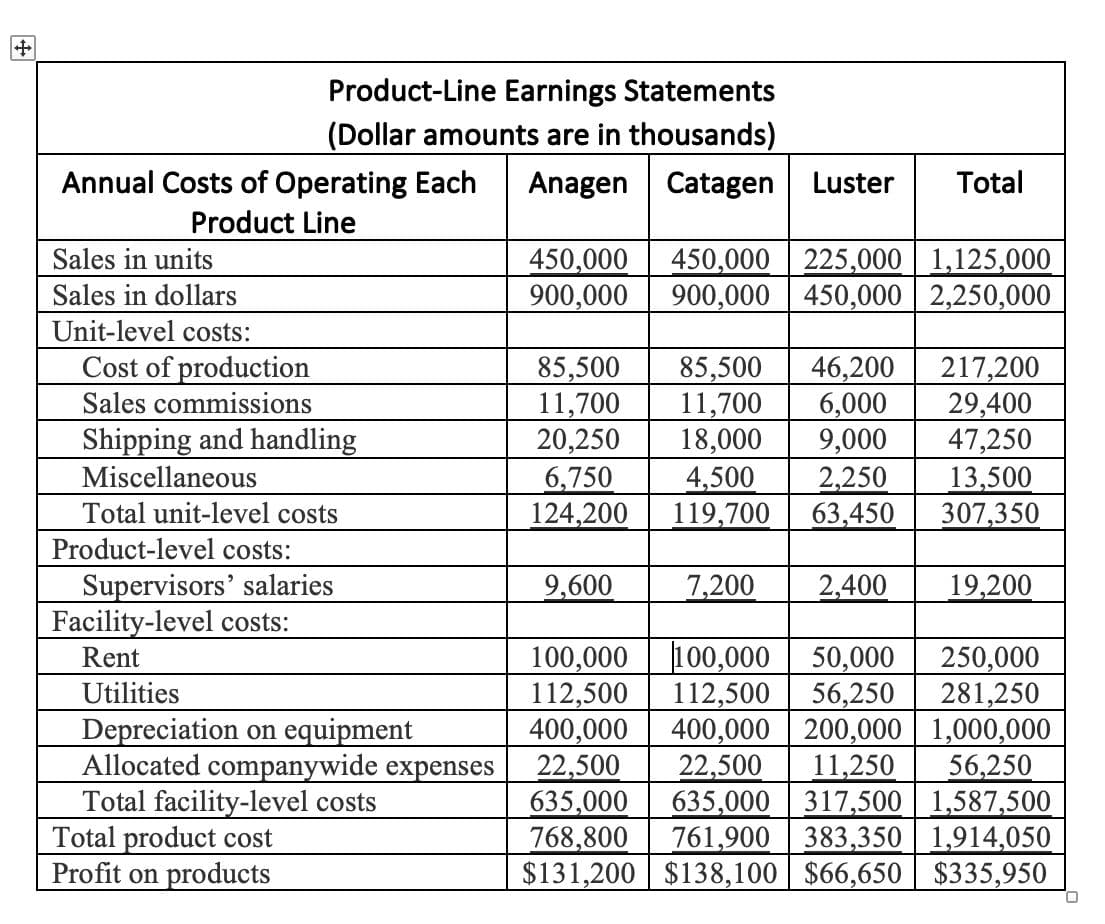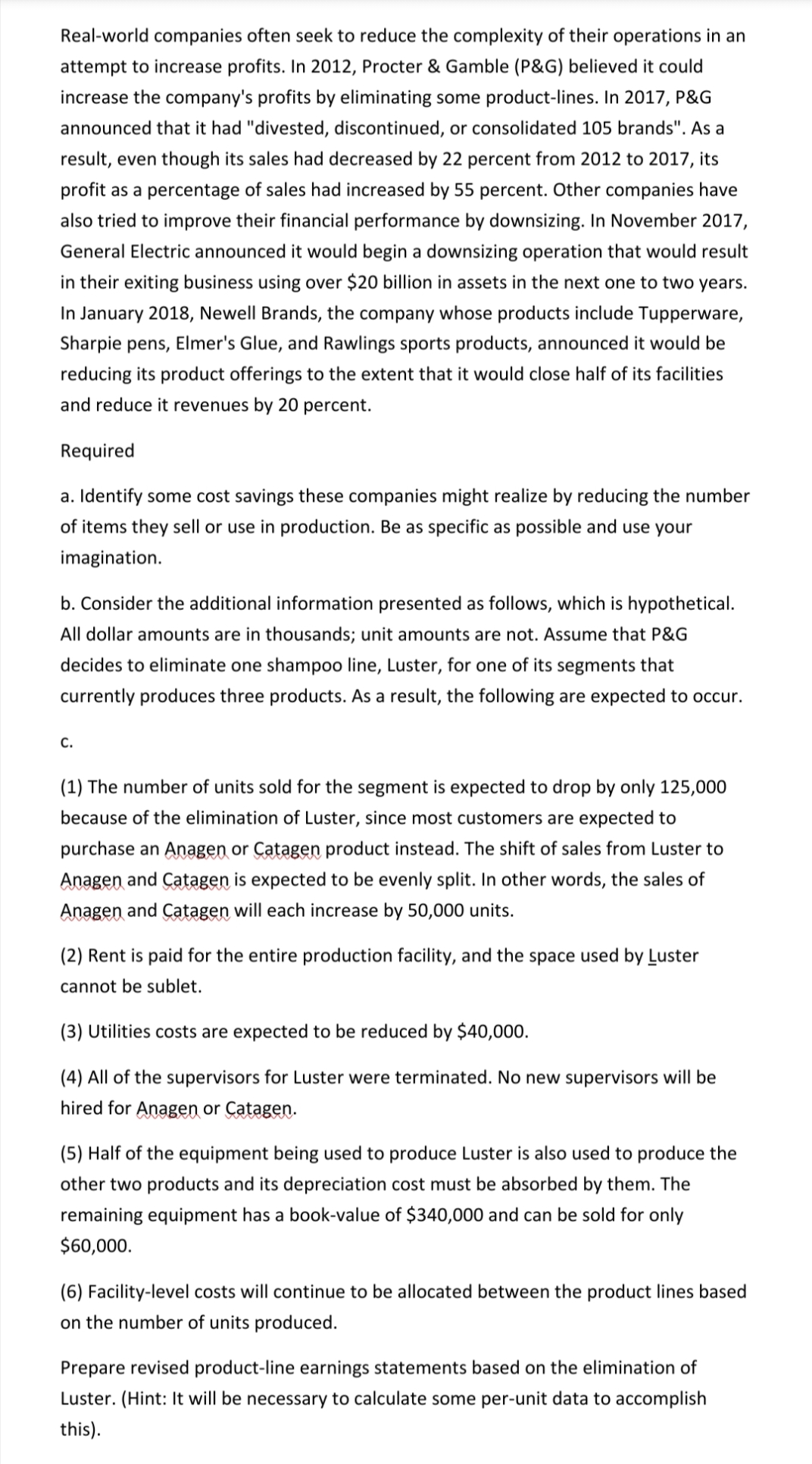Product-Line Earnings Statements (Dollar amounts are in thousands) Annual Costs of Operating Each Anagen Catagen Luster Total Product Line 450,000 900,000 450,000 225,000 1,125,000 900,000 450,000 2,250,000 Sales in units Sales in dollars Unit-level costs: Cost of production 85,500 11,700 20,250 6,750 124,200 85,500 11,700 18,000 4,500 119,700 46,200 6,000 9,000 2,250 63,450 217,200 29,400 47,250 13,500 307,350 Sales commissions Shipping and handling Miscellaneous Total unit-level costs Product-level costs: Supervisors' salaries Facility-level costs: 9,600 7,200 2,400 19,200 100,000 112,500 Rent 100,000 112,500 400,000 22,500 635,000 768,800 50,000 56,250 400,000 200,000 1,000,000 11,250 635,000 317,500 1,587,500 761,900 383,350 1,914,050 $131,200 $138,100 | $66,650 | $335,950 250,000 281,250 Utilities Depreciation on equipment Allocated companywide expenses Total facility-level costs Total product cost Profit on products 22,500 56,250
Product-Line Earnings Statements (Dollar amounts are in thousands) Annual Costs of Operating Each Anagen Catagen Luster Total Product Line 450,000 900,000 450,000 225,000 1,125,000 900,000 450,000 2,250,000 Sales in units Sales in dollars Unit-level costs: Cost of production 85,500 11,700 20,250 6,750 124,200 85,500 11,700 18,000 4,500 119,700 46,200 6,000 9,000 2,250 63,450 217,200 29,400 47,250 13,500 307,350 Sales commissions Shipping and handling Miscellaneous Total unit-level costs Product-level costs: Supervisors' salaries Facility-level costs: 9,600 7,200 2,400 19,200 100,000 112,500 Rent 100,000 112,500 400,000 22,500 635,000 768,800 50,000 56,250 400,000 200,000 1,000,000 11,250 635,000 317,500 1,587,500 761,900 383,350 1,914,050 $131,200 $138,100 | $66,650 | $335,950 250,000 281,250 Utilities Depreciation on equipment Allocated companywide expenses Total facility-level costs Total product cost Profit on products 22,500 56,250
Chapter3: Analysis Of Financial Statements
Section: Chapter Questions
Problem 1bM
Related questions
Question
100%

Transcribed Image Text:Product-Line Earnings Statements
(Dollar amounts are in thousands)
Annual Costs of Operating Each
Anagen Catagen
Luster
Total
Product Line
450,000
900,000
450,000 225.000 1,125,000
900,000 450,000 2,250,000
Sales in units
Sales in dollars
Unit-level costs:
Cost of production
85,500
11,700
20,250
6,750
124,200
85,500
11,700
18,000
4,500
119,700
46,200
6,000
9,000
2,250
63,450
217,200
29,400
47,250
13,500
307,350
Sales commissions
Shipping and handling
Miscellaneous
Total unit-level costs
Product-level costs:
Supervisors' salaries
Facility-level costs:
9,600
7,200
2,400
19,200
100,000
112,500
100,000
112,500
400,000
22,500
635,000
768,800
50,000
56,250
400,000 200,000 1,000,000
11,250
635,000 317,500 1,587,500
761,900 383,350 1,914,050
$131,200 $138,100 | $66,650 | $335,950
250,000
281,250
Rent
Utilities
Depreciation on equipment
Allocated companywide expenses
Total facility-level costs
Total product cost
Profit on products
22,500
56,250

Transcribed Image Text:Real-world companies often seek to reduce the complexity of their operations in an
attempt to increase profits. In 2012, Procter & Gamble (P&G) believed it could
increase the company's profits by eliminating some product-lines. In 2017, P&G
announced that it had "divested, discontinued, or consolidated 105 brands". As a
result, even though its sales had decreased by 22 percent from 2012 to 2017, its
profit as a percentage of sales had increased by 55 percent. Other companies have
also tried to improve their financial performance by downsizing. In November 2017,
General Electric announced it would begin a downsizing operation that would result
in their exiting business using over $20 billion in assets in the next one to two years.
In January 2018, Newell Brands, the company whose products include Tupperware,
Sharpie pens,
Elmer's Glue, and Rawlings sports products, announced it would be
reducing its product offerings to the extent that it would close half of its facilities
and reduce it revenues by 20 percent.
Required
a. Identify some cost savings these companies might realize by reducing the number
of items they sell or use in production. Be as specific as possible and use your
imagination.
b. Consider the additional information presented as follows, which is hypothetical.
All dollar amounts are in thousands; unit amounts are not. Assume that P&G
decides to eliminate one shampoo line, Luster, for one of its segments that
currently produces three products. As a result, the following are expected to occur.
C.
(1) The number of units sold for the segment is expected to drop by only 125,000
because of the elimination of Luster, since most customers are expected to
purchase an Anagen or Catagen product instead. The shift of sales from Luster to
Anagen and Catagen is expected to be evenly split. In other words, the sales of
Anagen and Catagen will each increase by 50,000 units.
(2) Rent is paid for the entire production facility, and the space used by Luster
cannot be sublet.
(3) Utilities costs are expected to be reduced by $40,000.
(4) All of the supervisors for Luster were terminated. No new supervisors will be
hired for Anagen or Catagen.
(5) Half of the equipment being used to produce Luster is also used to produce the
other two products and its depreciation cost must be absorbed by them. The
remaining equipment has a book-value of $340,000 and can be sold for only
$60,000.
(6) Facility-level costs will continue to be allocated between the product lines based
on the number of units produced.
Prepare revised product-line earnings statements based on the elimination of
Luster. (Hint: It will be necessary to calculate some per-unit data to accomplish
this).
Expert Solution
This question has been solved!
Explore an expertly crafted, step-by-step solution for a thorough understanding of key concepts.
This is a popular solution!
Trending now
This is a popular solution!
Step by step
Solved in 8 steps with 1 images

Knowledge Booster
Learn more about
Need a deep-dive on the concept behind this application? Look no further. Learn more about this topic, accounting and related others by exploring similar questions and additional content below.Recommended textbooks for you


Cornerstones of Cost Management (Cornerstones Ser…
Accounting
ISBN:
9781305970663
Author:
Don R. Hansen, Maryanne M. Mowen
Publisher:
Cengage Learning

Financial Reporting, Financial Statement Analysis…
Finance
ISBN:
9781285190907
Author:
James M. Wahlen, Stephen P. Baginski, Mark Bradshaw
Publisher:
Cengage Learning


Cornerstones of Cost Management (Cornerstones Ser…
Accounting
ISBN:
9781305970663
Author:
Don R. Hansen, Maryanne M. Mowen
Publisher:
Cengage Learning

Financial Reporting, Financial Statement Analysis…
Finance
ISBN:
9781285190907
Author:
James M. Wahlen, Stephen P. Baginski, Mark Bradshaw
Publisher:
Cengage Learning